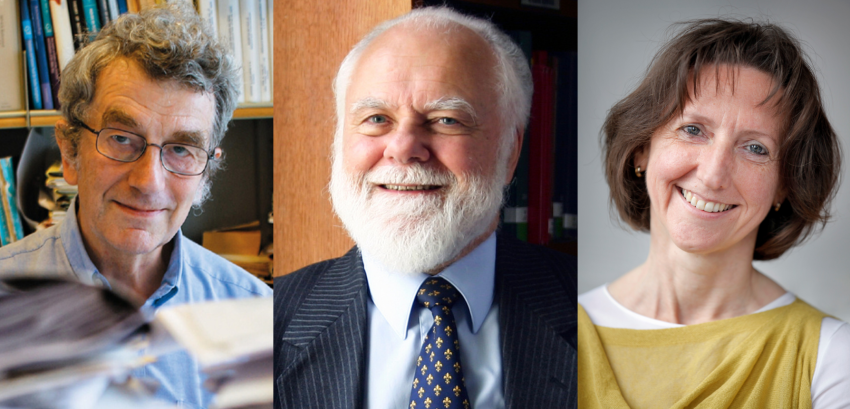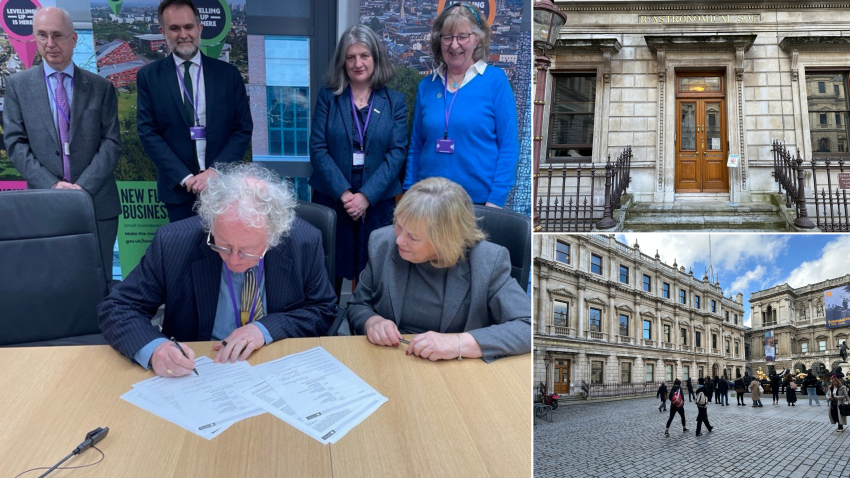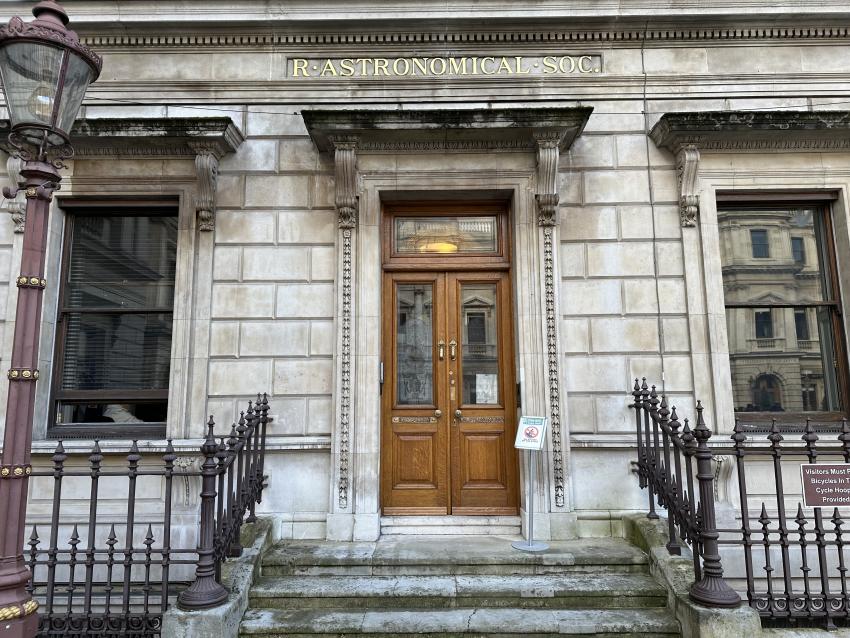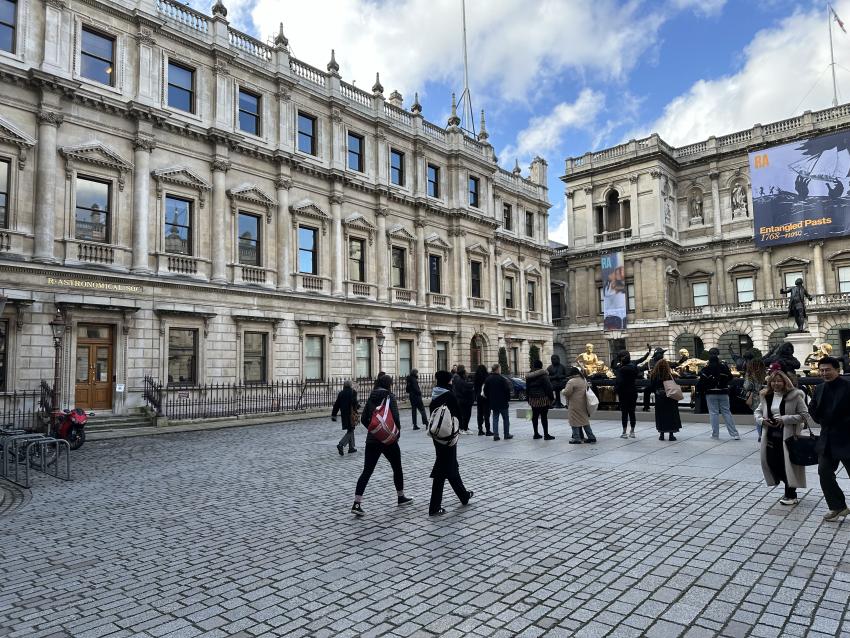Unlocking answers to ‘Twinkle, Twinkle, Little Star’ earns RAS Fellows prestigious prize

Jørgen Christensen-Dalsgaard (left), Douglas Gough (centre) and Conny Aerts (right) have been awarded the Crafoord Prize in Astronomy 2024 for unlocking the “secrets inside the Sun and stars”.

Jørgen Christensen-Dalsgaard (left), Douglas Gough (centre) and Conny Aerts (right) have been awarded the Crafoord Prize in Astronomy 2024 for unlocking the “secrets inside the Sun and stars”.
Credit
Royal Swedish Academy of Sciences
Licence type
Attribution (CC BY 4.0
For more than 200 years the nursery rhyme "Twinkle, Twinkle, Little Star" has posed a question astronomers have struggled to answer.
But thanks to three Fellows of the Royal Astronomical Society, we are now unlocking the secrets of just 'what stars are' and what is hidden inside them.
This groundbreaking work has been recognised with the awarding of the prestigious Crafoord Prize in Astronomy 2024 to Douglas Gough, Professor Emeritus at the University of Cambridge, Jørgen Christensen-Dalsgaard, of Aarhus University in Denmark, and Conny Aerts, of KU Leuven in Belgium.
The trio have been honoured by the Royal Swedish Academy of Sciences - which is also responsible for selecting the annual Nobel Prize winners - for uncovering "secrets inside the Sun and stars" and “bringing us new knowledge about phenomena that cannot be perceived by the human eye”.
Bengt Gustafsson, Professor Emeritus at Sweden’s Uppsala University and a member of the prize committee, said the laureates had given us the ability to answer the 19th century lullaby's question 'How I wonder what you are!' “by establishing an entirely new field of research, which studies the way that stars ‘twinkle’".
Of course, the main cause of the twinkling of stars we see from our perspective on Earth is because of the way their light passes through our atmosphere.
The twinkling referred to in this research is due to seismic waves in the stars, which is a much smaller effect.
The three scientists were recognised for discovering that methods used by seismologists to learn about earthquakes on Earth could also be applied to astronomy.
This so-called asteroseismology allows scientists to study the interior of the Sun and stars by monitoring movements on their surfaces caused by internal oscillations similar to soundwaves.
When Professor Gough started his theoretical work, he focused on the Sun and soon had the assistance of his doctoral student, Professor Christensen-Dalsgaard.
The pair, along with hundreds of other researchers, went on to establish a network called the GONG telescopes in 1995, which led to a series of new discoveries such as how the interior of the Sun rotates differently to its outer layer.
Professor Aerts used the same method to learn more about distant stars.
Thanks to this new technology, researchers are now able to measure the radius of stars and the composition of their interiors and to give them a more precise age.
“Twinkle, twinkle, little star, / how I wonder WHAT you are!” is the text of a well-known nursery rhyme,” said Professor Emeritus Gustafsson.
“Small changes that we perceive in a star’s brightness are also due to the oscillations in its interior.
“By establishing an entirely new field of research, which studies the way that stars ‘twinkle’, the laureates have given us the ability to answer the nursery rhyme’s question.
“We can learn more about the stars’ structure and rotation, as well as about the history of the Milky Way.”
Professor Mike Edmunds, president of the Royal Astronomical Society (RAS), congratulated all three RAS Fellows on their prize.
“The award of the Crafoord Prize this year to pioneers in the field of asteroseismology is very welcome, particularly since the three winners are Fellows of the Society,” he said.
“They have made a major contribution to the study of the Sun and stars. I am particularly delighted that one of them is my long-standing colleague Douglas Gough.
“I had the good fortune to learn all about stellar physics from his excellent graduate lectures when I was a research student.
“Many congratulations to all three.”
Royal Swedish Academy of Sciences
Licence type
Attribution (CC BY 4.0
For more than 200 years the nursery rhyme "Twinkle, Twinkle, Little Star" has posed a question astronomers have struggled to answer.
But thanks to three Fellows of the Royal Astronomical Society, we are now unlocking the secrets of just 'what stars are' and what is hidden inside them.
This groundbreaking work has been recognised with the awarding of the prestigious Crafoord Prize in Astronomy 2024 to Douglas Gough, Professor Emeritus at the University of Cambridge, Jørgen Christensen-Dalsgaard, of Aarhus University in Denmark, and Conny Aerts, of KU Leuven in Belgium.
The trio have been honoured by the Royal Swedish Academy of Sciences - which is also responsible for selecting the annual Nobel Prize winners - for uncovering "secrets inside the Sun and stars" and “bringing us new knowledge about phenomena that cannot be perceived by the human eye”.
Bengt Gustafsson, Professor Emeritus at Sweden’s Uppsala University and a member of the prize committee, said the laureates had given us the ability to answer the 19th century lullaby's question 'How I wonder what you are!' “by establishing an entirely new field of research, which studies the way that stars ‘twinkle’".
Of course, the main cause of the twinkling of stars we see from our perspective on Earth is because of the way their light passes through our atmosphere.
The twinkling referred to in this research is due to seismic waves in the stars, which is a much smaller effect.
The three scientists were recognised for discovering that methods used by seismologists to learn about earthquakes on Earth could also be applied to astronomy.
This so-called asteroseismology allows scientists to study the interior of the Sun and stars by monitoring movements on their surfaces caused by internal oscillations similar to soundwaves.
When Professor Gough started his theoretical work, he focused on the Sun and soon had the assistance of his doctoral student, Professor Christensen-Dalsgaard.
The pair, along with hundreds of other researchers, went on to establish a network called the GONG telescopes in 1995, which led to a series of new discoveries such as how the interior of the Sun rotates differently to its outer layer.
Professor Aerts used the same method to learn more about distant stars.
Thanks to this new technology, researchers are now able to measure the radius of stars and the composition of their interiors and to give them a more precise age.
“Twinkle, twinkle, little star, / how I wonder WHAT you are!” is the text of a well-known nursery rhyme,” said Professor Emeritus Gustafsson.
“Small changes that we perceive in a star’s brightness are also due to the oscillations in its interior.
“By establishing an entirely new field of research, which studies the way that stars ‘twinkle’, the laureates have given us the ability to answer the nursery rhyme’s question.
“We can learn more about the stars’ structure and rotation, as well as about the history of the Milky Way.”
Professor Mike Edmunds, president of the Royal Astronomical Society (RAS), congratulated all three RAS Fellows on their prize.
“The award of the Crafoord Prize this year to pioneers in the field of asteroseismology is very welcome, particularly since the three winners are Fellows of the Society,” he said.
“They have made a major contribution to the study of the Sun and stars. I am particularly delighted that one of them is my long-standing colleague Douglas Gough.
“I had the good fortune to learn all about stellar physics from his excellent graduate lectures when I was a research student.
“Many congratulations to all three.”
PLANNING TO STICK AROUND
Deal agreed for 999-year lease on RAS HQ

Professor Mike Edmunds, president of the Royal Astronomical Society (RAS), signs the Burlington House lease agreement (left) with Baroness Scott of Bybrook OBE, Parliamentary Under Secretary of State at the Department of Levelling Up, Housing and Communities. Pictured right is Burlington House and RAS HQ.
The Royal Astronomical Society (RAS) is delighted to announce that an agreement has been reached with the Government to secure a 999-year leasehold on the Society’s headquarters in London.
It protects the 150-year-old scientific and cultural ecosystem at Burlington House by transferring ownership of the 19th century building to the Learned Societies that call it home, including the RAS, the Geological Society (GSL), the Linnean Society (LSL), the Royal Society of Chemistry (RSC) and the Society of Antiquaries (SAL).
In return for the leasehold at a peppercorn rent, the RAS and its Learned Society neighbours will together make a one-off payment to the Department of Levelling Up, Housing and Communities (DLUHC).
The Societies have also agreed an expanded programme of outreach activity to drive the Levelling Up agenda by reaching groups and communities who may not otherwise have the opportunity to engage with their collections and their work.
RAS president Professor Mike Edmunds said he was “over the Moon and jumping a couple of galaxies” following the agreement.
“I am absolutely delighted that for the foreseeable future we will be able to keep our headquarters in Burlington House, surrounded by our fellow Learned Societies,” he added.
“This agreement protects 150 years of our history by ensuring the preservation of our precious library, archives and instrument collection.
“But equally as exciting are the possibilities it opens up for the future, including the potential for innovative public events involving all the Societies around the Courtyard.
“We can also continue to invest in developing the facilities at our central London base – which is so helpful in bringing together our membership on a regular basis – as well as stepping up our activities across the United Kingdom.”
Trustees of the RAS - after careful consideration of the options - concluded that the new deal was not only good value for money but also provided long-term security that will allow the organisation to fulfil its charitable purposes into the future.

The Royal Astronomical Society’s headquarters at Burlington House in London.
Prior to the agreement, the Learned Societies’ place at Burlington House had been under threat because of unaffordable rising rents, but the new deal provides them with a permanent home and protects a national asset for science and heritage.
The scientific hub, which sits at the heart of London’s Piccadilly and is also the residence of the Royal Academy of Arts, was built by the Government in the 19th century to support the work of the Societies that call it home.
Designed to bring people together to disseminate knowledge and serve the public interest, today the ecosystem at Burlington House is playing an important role as the world looks to solve pressing challenges.
From mitigating climate change and biodiversity loss, to understanding the origins of our universe and developing new methods to use the Earth’s resources sustainably, the building is where historical understanding and scientific discovery converge to help find the answers.
With a secure home and continued support from their members and funders, the Societies can now collectively build on their extensive public engagement work, continue to foster research, promote learning for all and inspire and engage communities across the UK and beyond.
Under the new deal, responsibility for the fabric of the building will also transfer from the Government to the charitable organisations, allowing them to focus on ambitions to make their headquarters more accessible and sustainable.
Baroness Scott of Bybrook OBE, Parliamentary Under Secretary of State at the Department of Levelling Up, Housing and Communities, said: “This is a great deal which gives the Learned Societies a strong foundation for the future, and delivers good value for taxpayers at the same time.
“We have been working hard to ensure that they can continue to deliver their valuable contribution to public life, and I am pleased that they now have a permanent home, making these important collections accessible to more people – especially young people.”
Ruth Allington, president of the GSL, said: “Our London base hosts an extensive programme of scientific conferences, meetings, public events and exhibitions, as well as our library and collections.
“This agreement enables us to continue to provide a base for geoscience to thrive, as well as to look forward to welcoming many more thousands of visitors to Burlington House over the coming decades.”

Burlington House is home to the Royal Astronomical Society, The Geological Society, The Linnean Society, The Royal Society of Chemistry, The Society of Antiquaries and Royal Academy of Arts.
Professor Anjali Goswami, president of the LSL, said: “We are delighted to join with the rest of the Courtyard Societies and secure the future Burlington House as a centre of science and heritage.
“The building is not only home to our unique collection, but a hub for our national and international work to understand, value and protect the natural world.
“For the Linnean Society, this deal begins a new stage in our evolution, allowing us to invest in our building and make it more sustainable and accessible.
“It provides a foundation for our strategy to manage our collections and engage with our members and the public to work on behalf of the natural world.”
RSC CEO Dr Helen Pain said: “We welcome the opportunity to secure our long-term occupancy of New Burlington House.
“The outcome of the discussions with the Government enables the continuation of our work in support of our charitable purpose.
“We have taken care to consider all options and make an informed decision based on the priorities of our Society and we are looking forward to the next chapter and working with our neighbours around the Courtyard.”
Professor Martin Millet, president of the SAL, said: “The Society of Antiquaries is delighted to see the long-running issue of its lease at Burlington House successfully resolved with the Government.
“This will enable the Society to further develop its work in supporting research into the human past and communicating such knowledge to a broad and diverse public. We are very grateful to the wide spectrum of people who have actively supported our campaign to achieve this.”

Professor Mike Edmunds, president of the Royal Astronomical Society (RAS), signs the Burlington House lease agreement (left) with Baroness Scott of Bybrook OBE, Parliamentary Under Secretary of State at the Department of Levelling Up, Housing and Communities. Pictured right is Burlington House and RAS HQ.
The Royal Astronomical Society (RAS) is delighted to announce that an agreement has been reached with the Government to secure a 999-year leasehold on the Society’s headquarters in London.
It protects the 150-year-old scientific and cultural ecosystem at Burlington House by transferring ownership of the 19th century building to the Learned Societies that call it home, including the RAS, the Geological Society (GSL), the Linnean Society (LSL), the Royal Society of Chemistry (RSC) and the Society of Antiquaries (SAL).
In return for the leasehold at a peppercorn rent, the RAS and its Learned Society neighbours will together make a one-off payment to the Department of Levelling Up, Housing and Communities (DLUHC).
The Societies have also agreed an expanded programme of outreach activity to drive the Levelling Up agenda by reaching groups and communities who may not otherwise have the opportunity to engage with their collections and their work.
RAS president Professor Mike Edmunds said he was “over the Moon and jumping a couple of galaxies” following the agreement.
“I am absolutely delighted that for the foreseeable future we will be able to keep our headquarters in Burlington House, surrounded by our fellow Learned Societies,” he added.
“This agreement protects 150 years of our history by ensuring the preservation of our precious library, archives and instrument collection.
“But equally as exciting are the possibilities it opens up for the future, including the potential for innovative public events involving all the Societies around the Courtyard.
“We can also continue to invest in developing the facilities at our central London base – which is so helpful in bringing together our membership on a regular basis – as well as stepping up our activities across the United Kingdom.”
Trustees of the RAS - after careful consideration of the options - concluded that the new deal was not only good value for money but also provided long-term security that will allow the organisation to fulfil its charitable purposes into the future.

The Royal Astronomical Society’s headquarters at Burlington House in London.
Prior to the agreement, the Learned Societies’ place at Burlington House had been under threat because of unaffordable rising rents, but the new deal provides them with a permanent home and protects a national asset for science and heritage.
The scientific hub, which sits at the heart of London’s Piccadilly and is also the residence of the Royal Academy of Arts, was built by the Government in the 19th century to support the work of the Societies that call it home.
Designed to bring people together to disseminate knowledge and serve the public interest, today the ecosystem at Burlington House is playing an important role as the world looks to solve pressing challenges.
From mitigating climate change and biodiversity loss, to understanding the origins of our universe and developing new methods to use the Earth’s resources sustainably, the building is where historical understanding and scientific discovery converge to help find the answers.
With a secure home and continued support from their members and funders, the Societies can now collectively build on their extensive public engagement work, continue to foster research, promote learning for all and inspire and engage communities across the UK and beyond.
Under the new deal, responsibility for the fabric of the building will also transfer from the Government to the charitable organisations, allowing them to focus on ambitions to make their headquarters more accessible and sustainable.
Baroness Scott of Bybrook OBE, Parliamentary Under Secretary of State at the Department of Levelling Up, Housing and Communities, said: “This is a great deal which gives the Learned Societies a strong foundation for the future, and delivers good value for taxpayers at the same time.
“We have been working hard to ensure that they can continue to deliver their valuable contribution to public life, and I am pleased that they now have a permanent home, making these important collections accessible to more people – especially young people.”
Ruth Allington, president of the GSL, said: “Our London base hosts an extensive programme of scientific conferences, meetings, public events and exhibitions, as well as our library and collections.
“This agreement enables us to continue to provide a base for geoscience to thrive, as well as to look forward to welcoming many more thousands of visitors to Burlington House over the coming decades.”

Burlington House is home to the Royal Astronomical Society, The Geological Society, The Linnean Society, The Royal Society of Chemistry, The Society of Antiquaries and Royal Academy of Arts.
Professor Anjali Goswami, president of the LSL, said: “We are delighted to join with the rest of the Courtyard Societies and secure the future Burlington House as a centre of science and heritage.
“The building is not only home to our unique collection, but a hub for our national and international work to understand, value and protect the natural world.
“For the Linnean Society, this deal begins a new stage in our evolution, allowing us to invest in our building and make it more sustainable and accessible.
“It provides a foundation for our strategy to manage our collections and engage with our members and the public to work on behalf of the natural world.”
RSC CEO Dr Helen Pain said: “We welcome the opportunity to secure our long-term occupancy of New Burlington House.
“The outcome of the discussions with the Government enables the continuation of our work in support of our charitable purpose.
“We have taken care to consider all options and make an informed decision based on the priorities of our Society and we are looking forward to the next chapter and working with our neighbours around the Courtyard.”
Professor Martin Millet, president of the SAL, said: “The Society of Antiquaries is delighted to see the long-running issue of its lease at Burlington House successfully resolved with the Government.
“This will enable the Society to further develop its work in supporting research into the human past and communicating such knowledge to a broad and diverse public. We are very grateful to the wide spectrum of people who have actively supported our campaign to achieve this.”
No comments:
Post a Comment